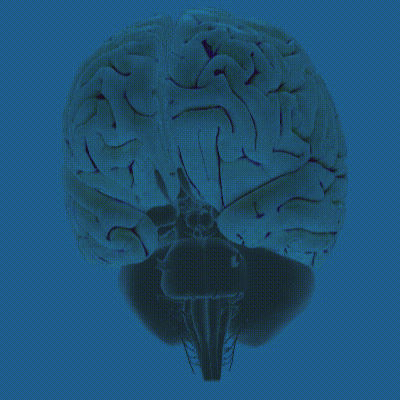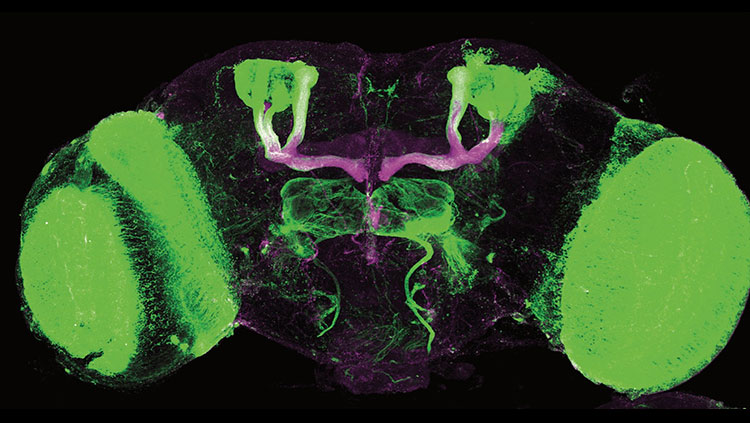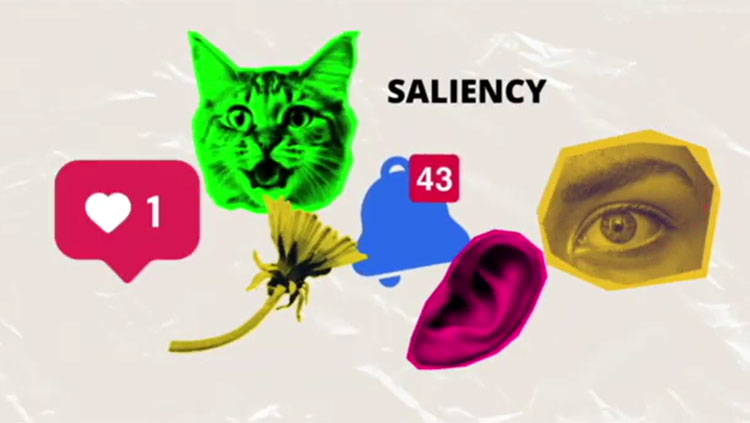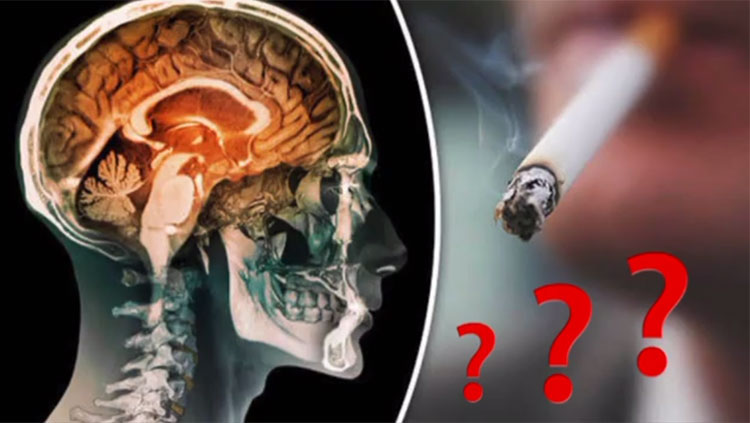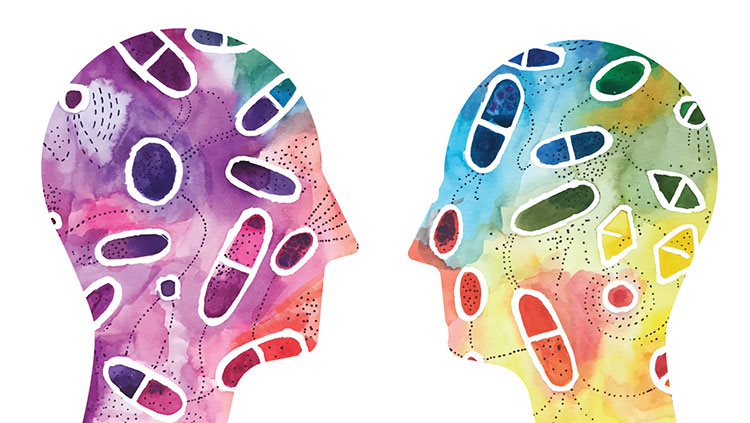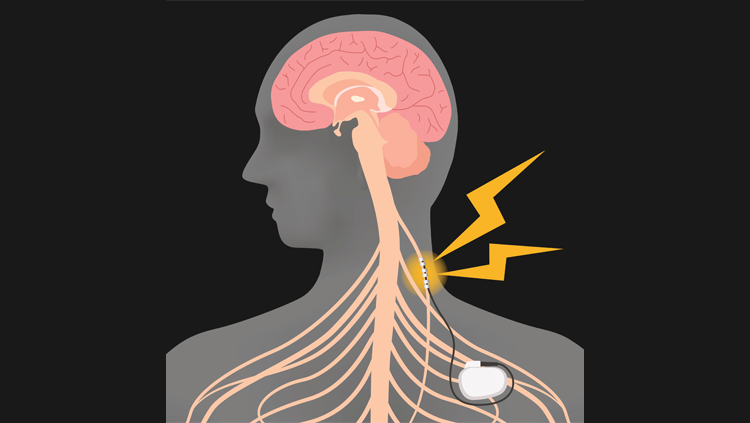Are We Losing the War on Nicotine Addiction?
- Published25 Sep 2018
- Reviewed25 Sep 2018
- Source BrainFacts/SfN
Written by Alison Davis and Alexis Wnuk

A ‘Receptive Substance’ for Nicotine
It only takes 10 seconds from the first drag off a cigarette for the nicotine in the smoke filling your lungs to surge through your bloodstream and enter your brain. Once there, nicotine triggers a rush that increases blood pressure, raises the heart rate, and quickens the breath. Every smoker who’s tried to quit can attest to the power and speed of nicotine’s effects.
How could one molecule exert so much power? The answer lies in the molecular docking station, or receptor, on neurons to which nicotine binds. The discovery of this receptor informed what we know about addiction and shaped the way we view smoking.
In 1905, British physiologist John Langley found nicotine elicited muscle contraction in birds. The muscles contracted even if the neurons controlling it had been removed. He reasoned nicotine interacted with some kind of “receptive substance” on the muscles to initiate contraction. A decade later, physiologist Henry Dale described how a compound derived from the ergot fungus called acetylcholine mimicked nicotine’s effects on muscle cells. Later, Dale and pharmacologist Otto Loewi found that animals make their own acetylcholine and use it as a neurotransmitter — a chemical messenger neurons use to communicate with each other and with other cells.

For decades, scientists around the world searched for acetylcholine’s receptive substance and tried to figure out how it translated a chemical signal into an electrical impulse. Using electric eels and rays as their study subjects, they found acetylcholine and its analogs latched onto a protein on the membrane of the fishes’ electric organs. In the 1970s, Jean-Pierre Changeux of the Pasteur Institute in Paris, extracted the nicotinic acetylcholine receptor and described its chemical structure — five protein subunits surrounding a central pore.
“There was a long period of time between the first electrophysiological discovery of these receptors in muscle … and the molecular discoveries of what those receptors look like,” says Marina Picciotto, a neuroscientist who studies addiction at Yale University. That process of discovery led to the understanding that nicotinic acetylcholine receptors in the brain contributed to addiction, she says.
A Role in Addiction
Within a few years of Changeux’s and others’ discoveries, scientists found the brain possessed its own nicotinic acetylcholine receptors, or nAChRs. This included regions of the brain comprising the reward system — the brain circuitry that processes rewards and motivates us to obtain them. Signaling in the reward system also drives addiction.
In the 1980s and ‘90s, Susan Wonnacott of the University of Bath in England found nAChRs in the brain enhanced neurotransmission in the reward system. Upon docking to the receptors, nicotine triggered neurons to release a flood of the neurotransmitter dopamine.
1998, Changeux’s lab at the Pasteur Institute, which included then postdoctoral fellow Marina Picciotto, found that a particular subunit of the five-unit nicotinic acetylcholine receptor was necessary for addiction. The nicotinic acetylcholine receptor is made up of five protein subunits surrounding a central, water-filled channel. The 15 different types of subunits identified in the human brain give rise to numerous receptor combinations, each with its own unique properties. Changeux’s team found mice lacking the beta 2 (β2) subunit didn’t experience the same rush of dopamine when given nicotine. They also didn’t seek out the drug later.
Changeux’s groups and other labs led by Henry Lester of the California Institute of Technology and Stephen Heinemann of the Salk Institute also identified the alpha 4 (α4) receptor subunit as an important contributor to the addictive properties of nicotine.
The findings “allowed us to say, ‘here is a target that is absolutely essential for nicotine to be rewarding,’” Picciotto says. “And so, you could now try to target that particular receptor for medications development.”
And, that is just what happened: Varenicline, better known as Chantix, is a smoking cessation drug that works by activating α4β2 receptors, but to a lesser extent than nicotine. Derived from a plant compound known to act on nicotine receptors, it quells nicotine cravings without producing a “buzz” or other undesired effects. The U.S. Food and Drug Administration approved Chantix as a smoking cessation treatment in May 2016.
E-Cigarettes: Nicotine by Any Other Name
In the 1950s, evidence began linking smoking to lung cancer. A 1964 report from the U.S. Surgeon General summarizing the health effects of smoking cemented this knowledge and fueled a major anti-smoking public-health campaign. In 1965, 40 percent of American adults smoked; by 2016, only 15 percent did.
But the electronic or e-cigarette threatens to reverse those gains. In 2016, nearly 11 million American adults used e-cigarettes. Proponents argue e-cigarettes are a safer alternative to tobacco cigarettes and could help people quit smoking.
While e-cigarettes don’t contain many of the toxins found in tobacco smoke, they still deliver nicotine to the brain, setting the stage for addiction.
While e-cigarettes don’t contain many of the toxins found in tobacco smoke, they still deliver nicotine to the brain, setting the stage for addiction. And, nicotine stimulates nAChRs in brain areas controlling thinking, attention, emotions, and appetite.
“We know that these receptors in the brain that are the targets of smoked nicotine didn’t evolve just so that we could roll up the tobacco leaf, set it on fire, and put it in our mouths,” Picciotto says. “These receptors evolved to do important work in the brain.” That work is especially critical for the developing brain.
In 2017, more than 2 million middle and high school students in the U.S. used e-cigarettes. When asked why, they cited the fruit and candy flavors and the belief that they are less harmful than other tobacco products.
Nicotine, however, disrupts the normal chemical and electrical activity in the developing brains of children and young adults. Both tobacco exposure in the womb and adolescent tobacco use have been linked to developmental and cognitive problems like attention deficit hyperactivity disorder, ADHD. In mice, rats, and humans, nicotine exposure during prenatal, juvenile, or adolescent development permanently altered brain structure and signaling.
The risk e-cigarettes pose for adults, however, is less clear. E-cigarettes have only been around since 2003, so their long-term health effects are unknown. In addition, manufacturers are not required to list the chemical ingredients comprising e-liquids. Some analysis indicates heating e-liquids generates dangerous chemicals like formaldehyde.
Continued funding from public and private sources will help scientists ascertain the safety of e-cigarettes and further our understanding of the health effects of nicotine use.
CONTENT PROVIDED BY
BrainFacts/SfN
References
Abreu-Villaça, Y., Seidler, F. J., Tate, C. A., & Slotkin, T. A. (2003). Nicotine is a neurotoxin in the adolescent brain: critical periods, patterns of exposure, regional selectivity, and dose thresholds for macromolecular alterations. Brain Research, 979(1–2), 114–128. https://www.ncbi.nlm.nih.gov/pubmed/12850578
Albuquerque, E. X., Pereira, E. F. R., Alkondon, M., & Rogers, S. W. (2009). Mammalian Nicotinic Acetylcholine Receptors: From Structure to Function. Physiological Reviews, 89(1), 73–120. doi:10.1152/physrev.00015.2008
Centers for Disease Control and Prevention, Office on Smoking and Health. (2018, February 22). Current Cigarette Smoking Among Adults in the United States. Retrieved September 7, 2018, from http://www.cdc.gov/tobacco/data_statistics/fact_sheets/adult_data/cig_smoking/
Changeux, J. P. (2012). The Nicotinic Acetylcholine Receptor: The Founding Father of the Pentameric Ligand-gated Ion Channel Superfamily. The Journal of Biological Chemistry, 287(48), 40207–40215. doi:10.1074/jbc.R112.407668
Changeux, J. P., Kasai, M., Huchet, M., & Meunier, J. C. (1970). Extraction from electric tissue of gymnotus of a protein presenting several typical properties characteristic of the physiological receptor of acetylcholine. Comptes Rendus Hebdomadaires Des Seances De l’Academie Des Sciences. Serie D: Sciences Naturelles, 270(23), 2864–2867. https://www.ncbi.nlm.nih.gov/pubmed/4987937
Changeux, J. P., Kasai, M., & Lee, C. Y. (1970). Use of a Snake Venom Toxin to Characterize the Cholinergic Receptor Protein*. Proceedings of the National Academy of Sciences of the United States of America, 67(3), 1241–1247. https://www.ncbi.nlm.nih.gov/pubmed/5274453
Changeux, J. P., Podleski, T. R., & Wofsy, L. (1967). Affinity labeling of the acetylcholine-receptor. Proceedings of the National Academy of Sciences of the United States of America, 58(5), 2063–2070. https://www.ncbi.nlm.nih.gov/pmc/articles/PMC223906/pdf/pnas00151-0245.pdf
Coe, J. W., Brooks, P. R., Vetelino, M. G., Wirtz, M. C., Arnold, E. P., Huang, J., … O’Neill, B. T. (2005). Varenicline: An α4β2 Nicotinic Receptor Partial Agonist for Smoking Cessation. Journal of Medicinal Chemistry, 48(10), 3474–3477. doi:10.1021/jm050069n
Ehrenpreis, S. (1959). Interaction of Curare and Related Substances with Acetylcholine Receptor-Like Protein. Science, 129(3363), 1613–1614. doi:10.1126/science.129.3363.1613
Feldberg, W. (1969). Henry Hallett Dale, 1875-1968. British Journal of Pharmacology, 35(1), 1–9. https://www.ncbi.nlm.nih.gov/pmc/articles/PMC1703091/
Jacobsen, L. K., Picciotto, M. R., Heath, C. J., Frost, S. J., Tsou, K. A., Dwan, R. A., … Mencl, W. E. (2007). Prenatal and Adolescent Exposure to Tobacco Smoke Modulates the Development of White Matter Microstructure. Journal of Neuroscience, 27(49), 13491–13498. doi:10.1523/JNEUROSCI.2402-07.2007
Jung, Y., Hsieh, L. S., Lee, A. M., Zhou, Z., Coman, D., Heath, C. J., Hyder, F., Mineur, Y. S., Yuan, Q., Goldman, D., Bordey, A. & Picciotto, M. R. (2016). An epigenetic mechanism mediates developmental nicotine effects on neuronal structure and behavior. Nature Neuroscience, 19(7), 905–914.
Karlin, A., & Winnik, M. (1968). Reduction and specific alkylation of the receptor for acetylcholine. Proceedings of the National Academy of Sciences of the United States of America, 60(2), 668–674. https://www.ncbi.nlm.nih.gov/pmc/articles/PMC225098/pdf/pnas00120-0324.pdf
Langley, J. N. (1905). On the reaction of cells and of nerve-endings to certain poisons, chiefly as regards the reaction of striated muscle to nicotine and to curari. The Journal of Physiology, 33(4–5), 374–413. https://www.ncbi.nlm.nih.gov/pmc/articles/PMC1465797/
Mirbolouk, M., Charkhchi, P., Kianoush, S., Uddin, S. M. I., Orimoloye, O. A., Jaber, R., … Blaha, M. J. (2018). Prevalence and Distribution of E-Cigarette Use Among U.S. Adults: Behavioral Risk Factor Surveillance System, 2016. Annals of Internal Medicine. doi:10.7326/M17-3440
Nachmansohn, D. (1961). Chemical Factors Controlling Nerve Activity: Analysis reveals the underlying chemical system that generates the currents responsible for nerve impulses. Science, 134(3494), 1962–1968. doi:10.1126/science.134.3494.1962
National Institute on Drug Abuse. (2018, January). How does tobacco deliver its effects? Retrieved September 5, 2018, from https://www.drugabuse.gov/publications/research-reports/tobacco-nicotine-e-cigarettes/how-does-tobacco-deliver-its-effects
National Institute on Drug Abuse. (2018, January). Is nicotine addictive? Retrieved September 5, 2018, from https://www.drugabuse.gov/publications/research-reports/tobacco-nicotine-e-cigarettes/nicotine-addictive
Picciotto, M. R., Zoli, M., Rimondini, R., Léna, C., Marubio, L. M., Pich, E. M., … Changeux, J. P. (1998). Acetylcholine receptors containing the β2 subunit are involved in the reinforcing properties of nicotine. Nature, 391(6663), 173–177. doi:10.1038/34413
Rapier, C., Lunt, G. G., & Wonnacott, S. (1990). Nicotinic modulation of [3H]dopamine release from striatal synaptosomes: pharmacological characterisation. Journal of Neurochemistry, 54(3), 937–945. https://www.ncbi.nlm.nih.gov/pubmed/2303820
Salvaterra, P. M., & Mahler, H. R. (1976). Nicotinic acetylcholine receptor from rat brain. Solubilization, partial purification, and characterization. The Journal of Biological Chemistry, 251(20), 6327–6334. https://www.ncbi.nlm.nih.gov/pubmed/977572
Slotkin, T. A., MacKillop, E. A., Rudder, C. L., Ryde, I. T., Tate, C. A., & Seidler, F. J. (2007). Permanent, sex-selective effects of prenatal or adolescent nicotine exposure, separately or sequentially, in rat brain regions: indices of cholinergic and serotonergic synaptic function, cell signaling, and neural cell number and size at 6 months of age. Neuropsychopharmacology: Official Publication of the American College of Neuropsychopharmacology, 32(5), 1082–1097. doi:10.1038/sj.npp.1301231
Tapper, A. R., McKinney, S. L., Nashmi, R., Schwarz, J., Deshpande, P., Labarca, C., … Lester, H. A. (2004). Nicotine activation of alpha4* receptors: sufficient for reward, tolerance, and sensitization. Science (New York, N.Y.), 306(5698), 1029–1032. doi:10.1126/science.1099420
Tsai, J., Walton, K., Coleman, B. N., Sharapova, S. R., Johnson, S. E., Kennedy, S. M., & Caraballo, R. S. (2018). Reasons for Electronic Cigarette Use Among Middle and High School Students — National Youth Tobacco Survey, United States, 2016. MMWR. Morbidity and Mortality Weekly Report, 67(6), 196–200. doi:10.15585/mmwr.mm6706a5
U.S. Department of Health and Human Services. (1989). Reducing the Health Consequences of Smoking: 25 Years of Progress. A Report of the Surgeon General. U.S. Department of Health and Human Services, Public Health Service, Centers for Disease Control, Center for Chronic Disease Prevention and Health Promotion, Office on Smoking and Health. Retrieved from https://profiles.nlm.nih.gov/ps/access/NNBBXS.pdf
U.S. Department of Health and Human Services. (2000). Chapter 2: A Historical Review of Efforts to Reduce Smoking in the United States. In Reducing Tobacco Use: A Report of the Surgeon General. Atlanta, GA: U.S. Department of Health and Human Services, Centers for Disease Control and Prevention, National Center for Chronic Disease Prevention and Health Promotion, Office on Smoking and Health. Retrieved from http://www.cdc.gov/tobacco/data_statistics/sgr/2000/complete_report/
Wang, T. W., Gentzke, A., Sharapova, S., Cullen, K. A., Ambrose, B. K., & Jamal, A. (2018). Tobacco Product Use Among Middle and High School Students — United States, 2011–2017. MMWR. Morbidity and Mortality Weekly Report, 67(22), 629–633. doi:10.15585/mmwr.mm6722a3
Yoshida, K., & Imura, H. (1979). Nicotinic cholinergic receptors in brain synaptosomes. Brain Research, 172(3), 453–459. https://www.ncbi.nlm.nih.gov/pubmed/476492


